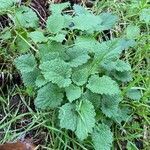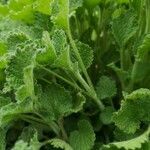Aromatic herb 0.3-0.6 m tall; stems few to several from a perennial rhizome, erect, lanate, somewhat woody at the base. Leaves petiolate; blade broadly ovate to subrotund, 20-45 x 18-45 mm, sparingly to densely tomentose above, densely lanate below, apex rounded to obtuse, base cuneate, margin crenate-dentate; petiole 5-14 mm long. Inflorescence simple, of 4-12 spaced verticils; bracteoles linear-filiform, 5-7 mm long, villous. Calyx 5-8 mm long at flowering, scarcely enlarging; tube about 4-5 mm long, stellate-hispid; teeth 10, subulate, spine-tipped, 1.5-3 mm long, spreading, bent or hooked at the apex. Corolla 7-8 mm long; upper lip 2.5 mm long; lower lip 2.5-3 mm long. Nutlets smooth, 2 mm long.
Perennial herb, 0.3-0.6 m high; stems few to several; erect, base woody, lanate. Leaves petiolate, ovate to subrotund, base cuneate, apex rounded, margins crenate-dentate; tomentose above, densely lanate below. Inflorescences simple, of 4-12 spaced verticillasters; bracteoles linear-filiform, villous. Flowers white to purplish. Calyx: tube stellate-hispid; teeth 10, subulate, spine-tipped, spreading, bent or hooked at apex. Corolla: tube included in calyx, glabrous or with ring of hairs within; upper lip erect, flat or concave, entire to deeply 2-fid; lower lip spreading, 3-fid. Stamens 4, didynamous, included in corolla tube. Flowering time Oct.-May. Fruit smooth, ovoid nutlets.
Taprooted perennial, the stems generally several, 3–10 dm, nearly prostrate to suberect, conspicuously white-woolly; lvs wholly cauline, canescent-woolly or partly subglabrate, not much reduced upward, petiolate, the blade broadly elliptic to rotund-ovate, evidently crenate, 2–5.5 cm; cal stellate and often ± long-hairy, the tube 4–5 mm, the 10 narrow, firm teeth somewhat shorter, eventually widely spreading, their spinulose tips recurved from the first; cor whitish, slightly exserted, with subequal lips; 2n=34, 36. Native of Eurasia, escaped and established in disturbed habitats nearly throughout the U.S. and s. Can. June–Aug.
Much-branched herb with stems to c. 50 cm tall, ± lanate. Petioles slender, < to > lamina, lanate or densely hairy. Lamina 1-3.5 × 1-4.5 cm, broad-ovate to suborbicular, rugose, white-tomentose except for upper surface when mature, crenate or crenate-dentate; base truncate to cuneate in upper lvs and bracts, subcordate in lower lvs; apex obtuse. Verticels dense, globose. Calyx tube 4-6 mm long, with stellate tomentum; teeth 10, rigid, subulate, hooked. Corolla c. 1 cm long, white-tomentose outside; lower lip broader than long. Nutlets c. 2.5 mm long, ± obovoid, sharply keeled.
A herb. The plant which keeps growing from year to year. The taproot is stout and branched. The stems are erect and white and woolly. They are square. It grows 80 cm high. The leaves are soft and wrinkled. They are oval to round and 1.5-3.5 cm across. They are pale grey-green. They have distinct net veins underneath. The leaves have blunt teeth around the edge. The flowers are white. They have lips and are tubular. They occur in round clusters up the stem. The nutlets are oblong and have 3 angles. They are 2 mm long.
Perennial herb, 0.3-0.6 m high. Stems few to several from a perennial rhizome. Leaves petiolate; blade broadly ovate to subrotund, 20-45 x 18-45 mm, apex rounded to obtuse, base cuneate, margins crenate-dentate; petioles 5-14 mm long. Flowers: in dense, many-flowered verticils; calyx 5-8 mm long, stellate-pubescent, teeth 10, spine-tipped, bent or hooked at apex; corolla with tube included in calyx, 7-8 mm long, white to purplish; Nov.-Mar.












